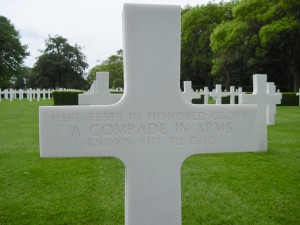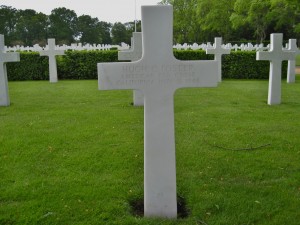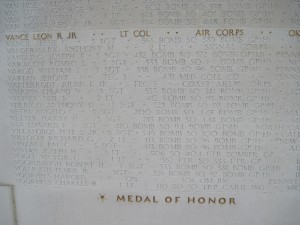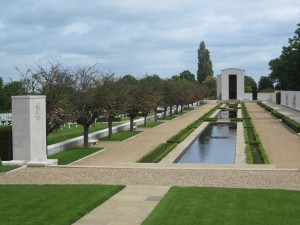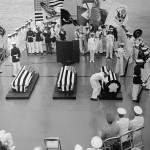Archive for the 'Unknown Soldier' Category
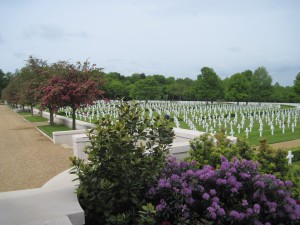 There are few more humbling experiences for an American than to visit one of the numerous American military cemeteries erected and lovingly maintained on foreign soil. I recently visited the American WWII Cemetery in Cambridge, England. Contained within its 30 acres are the graves of 3,809 Americans who lost their lives during WWII. Engraved on a 472-foot limestone wall on one side of the cemetery are the names of 5,126 others – missing in action, lost or buried at sea, or those “Unknowns” whose remains could not be positively identified prior to their interment in the cemetery.
There are few more humbling experiences for an American than to visit one of the numerous American military cemeteries erected and lovingly maintained on foreign soil. I recently visited the American WWII Cemetery in Cambridge, England. Contained within its 30 acres are the graves of 3,809 Americans who lost their lives during WWII. Engraved on a 472-foot limestone wall on one side of the cemetery are the names of 5,126 others – missing in action, lost or buried at sea, or those “Unknowns” whose remains could not be positively identified prior to their interment in the cemetery.
Time seems to stand still within the cemetery. Familiar names can be found on the Tablets of the Missing – Glenn Miller, Joseph P. Kennedy, Jr. and others. Among the graves in the cemetery are the graves of “unknowns”. Their earthly remains were never identified, yet those remains are buried in the cemetery and their names are engraved somewhere on the Tablets of the Missing. It’s an eerie feeling standing over an unknown grave and then gazing at the thousands of names on the wall – wondering which name on the wall identifies the American who gave everything resting below your feet…
I saw the grave of an American who was serving with the American Red Cross. Hugh Foster ran what was said to be the finest Red Cross canteen in all of England. Stories about his canteen can be found in many WWII memoirs. Being a non-combatant did not spare Mr. Foster from the ravages and dangers of war, however. He died in a bombing raid. He is buried among the American military men who found his canteen a welcome refuge – a place of rest and relaxation. I am certain they are honored by his presence. He is among friends.
Etched in gold lettering on the memorial wall is the name “Lt. Col Leon R. Vance, Jr.” Vance is the only serviceman honored in the cemetery to be awarded the Medal of Honor. A copy of his Medal of Honor citation is on display in the visitor’s building at the cemetery. It speaks for itself.
“For conspicuous gallantry and intrepidity above and beyond the call of duty on 5 June 1944, when he led a Heavy Bombardment Group, in an attack against defended enemy coastal positions in the vicinity of Wimereaux, France. Approaching the target, his aircraft was hit repeatedly by antiaircraft fire which seriously crippled the ship, killed the pilot, and wounded several members of the crew, including Lt. Col. Vance, whose right foot was practically severed. In spite of his injury, and with 3 engines lost to the flak, he led his formation over the target, bombing it successfully. After applying a tourniquet to his leg with the aid of the radar operator, Lt. Col. Vance, realizing that the ship was approaching a stall altitude with the 1 remaining engine failing, struggled to a semi-upright position beside the copilot and took over control of the ship. Cutting the power and feathering the last engine he put the aircraft in glide sufficiently steep to maintain his airspeed. Gradually losing altitude, he at last reached the English coast, whereupon he ordered all members of the crew to bail out as he knew they would all safely make land. But he received a message over the interphone system which led him to believe 1 of the crewmembers was unable to jump due to injuries; so he made the decision to ditch the ship in the channel, thereby giving this man a chance for life. To add further to the danger of ditching the ship in his crippled condition, there was a 500-pound bomb hung up in the bomb bay. Unable to climb into the seat vacated by the copilot, since his foot, hanging on to his leg by a few tendons, had become lodged behind the copilot’s seat, he nevertheless made a successful ditching while lying on the floor using only aileron and elevators for control and the side window of the cockpit for visual reference. On coming to rest in the water the aircraft commenced to sink rapidly with Lt. Col. Vance pinned in the cockpit by the upper turret which had crashed in during the landing. As it was settling beneath the waves an explosion occurred which threw Lt. Col. Vance clear of the wreckage. After clinging to a piece of floating wreckage until he could muster enough strength to inflate his life vest he began searching for the crewmember whom he believed to be aboard. Failing to find anyone he began swimming and was found approximately 50 minutes later by an Air-Sea Rescue craft. By his extraordinary flying skill and gallant leadership, despite his grave injury, Lt. Col. Vance led his formation to a successful bombing of the assigned target and returned the crew to a point where they could bail out with safety. His gallant and valorous decision to ditch the aircraft in order to give the crewmember he believed to be aboard a chance for life exemplifies the highest traditions of the U.S. Armed Forces.”
Leon Vance survived ditching his aircraft in the English Channel, although he would lose his right foot and lower leg. After receiving medical treatment for almost two months in England he was sent back to the United States for further treatment and the possible fitting of a prosthetic foot. In one of the cruel ironies of war, the C-54 Skymaster transport on which he was flying disappeared and was presumed to have crashed in the Atlantic between Iceland and Newfoundland on July 26, 1944. No trace of the aircraft has ever been found. Leon Vance and all aboard were lost at sea…
On this Memorial Day it seems an appropriate time to share the story of the selection of the WWII Unknown Soldier – and of the burial at sea of another WWII unknown soldier.
The Unknown Soldier of WWII was not selected until 1958. Nineteen bodies of unknown American soldiers (thirteen from the European Theater of Operations and six from the Pacific Theater) were exhumed from cemeteries in Europe, Africa, the Philippines and Hawaii. All nineteen remains were placed in identical caskets. The European unknowns were shipped to the U.S. cemetery in Epinal, France. The Pacific unknowns were shipped to Hickam Air Force Base, Hawaii. One set of remains was selected from each Theater of Operation – the European unknown selected by an Army General and the Pacific unknown by an Air Force Colonel. The remains not selected were reburied in France and Hawaii. The two caskets remaining were eventually transferred to the U.S.S. Canberra, a guided-missle frigate resting outside the Virginia Capes, along with the Unknown Soldier of the Korean War, also selected in Hawaii from four unknowns from that conflict. Three morticians aboard the Canberra took turns changing the positions of the caskets of the WWII dead, each time alone in a closed space, in total secrecy. The Korean War Unknown Soldier was then placed on the deck of the Canberra, with the two remaining WWII unknowns placed on each side. To quote the official Arlington Cemetery account:
“Navy Hospitalman 1st Class William R. Charette, then the Navy’s only active-duty Medal of Honor recipient, selected the Unknown Soldier of World War II. The remaining casket received a solemn burial at sea.
It’s almost hard to comprehend the journey of the American soldier who was buried at sea from the U.S.S. Canberra that day. It has to be one of the strangest journeys to a final resting place in history. One can only contemplate the endless mystery. Where was he born and raised – the Kansas prairie, the Bronx, the Maine coast, the Arizona desert – or was he an immigrant from Naples or Dublin or Manila? Did he die at Normandy, Guadalcanal, Peleliu, or over the skies of Germany? Was he once buried next to his close comrades and his friends – or was he originally buried in a grave next to no one he ever knew? One thing is probably certain, however, the very instant before he died he never expected to be buried alone at sea off the Virginia Capes more than a decade later.
Navy Hospitalman 1st Class William R. Charette selects the Unknown Soldier of WWII on the deck of the U.S.S. Canberra (May 1958). The center casket contains the remains of the Korean War Unknown Soldier. The casket on the left would be buried at sea off the Virginia Capes.
Additional information on the selection of the WWII Unknown Soldier can be found at these two fascinating websites:
http://www.arlingtoncemetery.org/visitor_information/tomb_of_the_unknowns.html
http://www.arlingtoncemetery.net/unk-w2ko.htm
